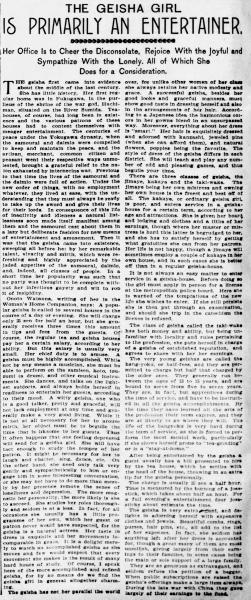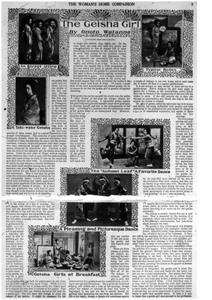The geisha first came into evidence about the middle of the last century. She has little history. Her first regular home was in Fukugawa, in the purlieus of the shrine of the war-god Hachiman, situated on the river Sumida. Tea-houses, of course, had long been in existence, and the various patrons of these houses had to content themselves with meager entertainment. The centuries of peace under the Tokugawa dynasty, when the samourai and daimio were compelled to keep and maintain the peace, and the artisan, merchant, common citizen and peasant went their respective ways unmolested, brought a grateful relief to the nation exhausted by internecine war. Previous to that time the samourai and the daimio were full of action. Under the new order of things, with no employment whatever, they lived at ease, with the understanding that they must always be ready to take up the sword and give their lives for their lords. In consequence of this life of inactivity and idleness a natural listlessness soon made itself manifest among them, and the samourai cast about them in a lazy but deliberate fashion for new means of entertainment and amusement. Then it was that the geisha came into existence, sweeping all before her by her remarkable talent, vivacity and mirth, which were refreshing and highly appreciated by the jaded appetites of the samourai, daimio, and indeed all classes of people. In a short time her popularity was such that no party was thought to be complete without her infectious gaiety and wit to rob it of insipidity.
Onoto Watanna, writing of her in the Woman’s Home Companion, says: A popular geisha is called to several houses in the course of a day or evening. She will charge only 25 sen for half an hour, but she generally receives three times this amount in tips and fees from the guests. Of course, the regular tea and geisha houses pay her a certain salary, according to her ability. But this salary is usually very small. Her chief duty is to amuse. A geisha must be highly accomplished. While not by any means a musician, she must be able to perform on the samisen, koto, tzuzumi (a drum) and other musical instruments. She dances, sings, and talks on the lightest subjects, and always holds herself in readiness to entertain her guests according to their mood. A witty geisha, one who is a good talker, pretty and graceful, will not lack for employment at any time, and generally makes a very good living. While it is not at all necessary for her to arouse mirth, her object must be to beguile the time that is irksome to her guests. Thus it often happens that one feeling depressed will send for a geisha girl. She will have tact enough to study the temper of her patron. It may be necessary for her to laugh and chatter, sing, dance, etc. On the other hand, she need only talk very gently and sympathetically to him or engage him in some interesting conversation, or she may not have to do more than merely by her presence remove the sense of loneliness and depression. The more magnetic her personality, the more likely is she to succeed. She studies her roles thoroughly, and seldom is at a loss. In fact, for all occasions she usually has a little programme of her own, which her guest or patron never would have suspected, for the geisha is a natural actress. Her taste in dress is exquisite, and her movements incomparable in grace. It is a delight merely to watch an accomplished geisha as she moves, and few would suspect that every movement she makes is the result of many hard hours of study. Of course, I speak here of the more accomplished and refined geisha, for by no means do we find the geisha girl in general altogether charming.
The geisha has not her parallel the world over, for unlike other women of her class she always retains her native modesty and grace. A successful geisha, besides her good looks and graceful manners, must show good taste in dressing herself, and also in the arrangements of her hair. According to a Japanese idea the harmonious colors in her gowns blend in an unsurpassed way. Moreover, everything about her dress is “smart.” Her hair is exquisitely dressed, and adorned with kanzashi, jeweled pins (when she can afford them), and natural flowers, poppies being the favorite. The style of dress of the geisha differs in each district. She will teach and play any number of odd and pleasing games, and thus beguile your time.
There are three classes of geisha, the jimaye, kakaye and the taki-wake. The jimaye being her own mistress and owning her own house is the freest and best off of all. The kakaye, or ordinary geisha girl, is poor, and enters service in a geisha house for a certain term, according to her age and attractions. She is given her board and lodging and clothes and a tithe of her earnings, though where her master or mistress is hard this latter is begrudged to her, and she has to satisfy herself by getting what gratuities she can from her patrons. Her life is not happy, though a jimaye will sometimes employ a couple of kakaye in her own house, and in such cases she is better off than in a regular geisha house.
It is not always an easy matter to enter service in a geisha-house. Before doing so the girl must apply in person for a license at the metropolitan police board. Here she is warned of the temptations of the new life she wishes to enter. If she still persists she is then put through an examination, and should she trip in the catechism the license is refused.
The class of geisha called the taki-wake has both money and ability, but being unfamiliar with locality and rules pertaining to the profession she puts herself in charge of a geisha of established reputation, and agrees to share with her her earnings.
The very young geishas are called the hang-yoku, or half-fees, and they are permitted to charge but half that charged by the older ones. They generally run between the ages of 13 to 15 years, and are bound to serve from five to seven years. They are, in fact, but apprentices during the time of service, and have to be instructed in all the geisha accomplishments. By the time they have learned all the arts of the profession their term expires, and they are at liberty to go where they will. The life of the hangyoku is very hard during the term of service, as she is forced to perform the most menial work, particularly if she shows herself prone to “tea-grinding” or is a “stay-at-home.”
After being entertained by the geisha a guest usually has a bill presented to him by the tea-house, which he settles with the head of the house, throwing in an extra tip for the geisha personally.
The charge is usually 25 sen a half hour. Time is measured by the burning of a joss-stick, which takes about half an hour. For a full evening’s entertainment four joss-sticks about estimate the time.
The geisha is very extravagant, and delights in adorning herself with expensive clothes and jewels. Beautiful combs, rings, purses, hair-pins, etc., all add to the list of her expenses. In fact, she seldom has anything left after her dress is accounted for, though a great many of them are most unselfish, giving largely from their earnings to their families, in some cases being the main or sole support of a large family.
They are as generous as extravagant, and seldom refuse the petition of a beggar. When public subscriptions are raised the geisha’s offerings make a large item always. During the late war with China they gave largely of their earnings to the fund.

